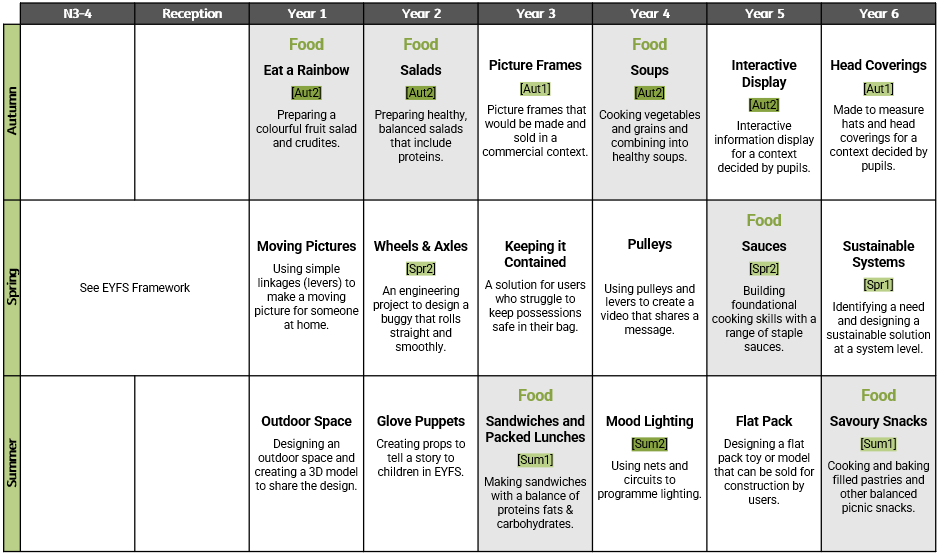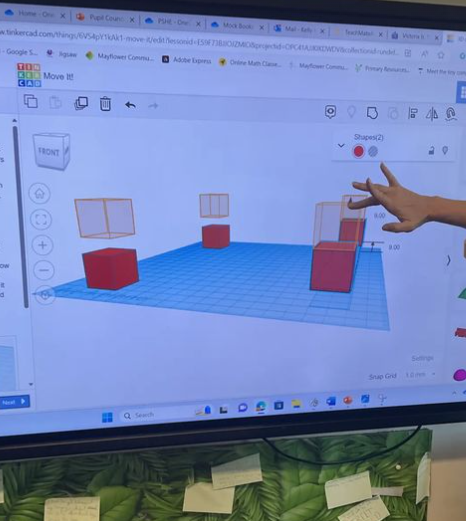Extended Opportunities
Extending the Design and Technology (DT) offer
DT Opportunities are plotted in a sequential and progressive manner. They add breadth and depth to key concepts that are taught across the curriculum. They also extend these concepts beyond the curriculum itself.
Extended Opportunities are mapped as:
1. Extension of core concepts (core DT concepts). These are primarily focused on articulating the process of design into making. These are organised as opportunities for pre-teaching or deepening and extending
2. Extension of curriculum knowledge and skills through wider design and making experience (aspirationally alongside experts)
3. Extension of the Primary Curriculum and linking into Secondary / Higher Education
4. Extension of exhibiting opportunities linking outcomes to a wider variety of designers and authentic audiences. These include a) in person b) digital and online
What is taught and when?

Extending what is taught.
Trips
Year 6
City College Plymouth
Why this and why now? Pupils are introduced to the opportunities that exist within further education in the field of Design Technology. Utilising expert workspaces, pupils develop their cutting and making skills in a specialist environment. They have the opportunity to embed skills from the focussed practical tasks that they undertook within school. Impact: By exposing pupils to industry experts who can instruct them over a period of time, within enabling environments such as purpose-built workshops, pupils' self-esteem and final outcomes have been significantly enhanced. So much so, that scale and full-size models have been built to spec.
Architect Company
Why this and why now? Pupils knowledge of the design into making process has been extended beyond the classroom by linking and working alongside industry experts (architects). ADG Architects modelled the process and suggested tweaks to pupils' design features in order to match the clients' real-life brief. This happens in Year 6 as an ultimate example of the entire DT curriculum coming together to form a life-size and scale product. For example, in year 1, pupils learnt how to join materials together by simple methods (e.g. glue/split pins); progressing through to using more complex materials and joints such as butt joints.
Impact: closer to industry standard outcomes enhanced by working with industry standards.
Drake's Island
Why this and why now? Pupils developed their understanding of the client's design criteria by undertaking a site visit with the client. This enabled pupils to be exposed to relevant, real-life contexts in order to further develop their designs. Pupils questioned and explored the positive and negative aspects of each site, understanding the client's needs.
Expert Visitors
Year 2
Rudra Patil
Why this and why now? Expert chair maker and designer Rudra Patil explained the design process to pupils. This provided expert knowledge of the design process and allowed pupils to explore different techniques suitable for creating a product. By having an expert explain the process, pupils were able to understand what joining techniques are needed.
Year 3
Clean Our Patch
Why this and why now? Community group Clean Our Patch provided unique insights into real-life opportunities linked to Year 3's levers and linkages concept. By linking with a local community group, pupils were able to understand the real-life application of the concept which they were studying. The community group representatives, El and Ash, were able to provide feedback on the relevancy of pupil's designs, utilising their unique skills and knowledge to aid pupils' designs.
Year 6
ADG Architects
Why this and why now? Industry experts ADG architects supported pupils' knowledge and skills through design development; contextualising the design process and detail needed to produce a high-quality, industry standard design. Working alongside pupils, they enhanced pupil designs, ensuring they were communicated to an industry level. By working alongside these experts, pupils were exposed to new and engaging experiences.
Tuition
Year 4, Year 5 and Year 6
Expert Tuition
Why this and why now? Mayflower is fortunate to have a resident expert in the guise of the site manager, David Brandenburg. Mr. Brandenburg is responsible for site maintenance and his field of expertise is electrical systems. His expertise in this (and other) fields, enables pupils full-time access to his professional skills; ensuring an expert is on hand to answer questions when they occur.
Workshops
Year 3
Here at Mayflower Community Academy we value the contributions our families make to our pupils' learning. As such, parents and carers are invited to share and enhance learning experiences. In autumn term, pupils and their families (primarily from year 3) will be invited to take part in a sewing workshop to build on the skills they learnt in year 2. Using a range of stitches, pupils and their families will work together to cut out and sew a variety of Christmas decorations which will be used in our community celebrations. This workshop will take place on Monday 25th November, Monday 2nd December and Monday 9th December between 3:30 and 4:15pm in the MAC (reception area)
Year 6
Tinkercad | 3D design
Why this and why now? With the development of advancements in technology, pupils need to be given the skills for the future. In Year 6, pupils are prepared for their secondary school education by exposure to different ways of working. Tinkercad is used to develop their understanding of 3D design in order to generate high quality outcomes with the view to develop their skills to allow them to undertake 3D printing.

Year 1
Puppets | Templates and Joining
Why this and why now? Pupils will share and explain the design process they undertook to complete their puppets. They will articulate the process of design into making, deepening and extending their knowledge and skills. Parents and carers will work alongside pupils to explore the techniques and processes that pupils undertake.
EYFS
Joining Techniques
Why this and why now? Pupils will share the design process they undertook to complete their cards. By providing pupils will relevant materials in a pre-designed and organised pack, pupils will articulate the process of design into making, deepening and extending their knowledge and skills. Parents and carers will work alongside pupils to explore the techniques and processes that pupils undertake.
Performance | Exhibit | Apply
The Market Hall
Autumn Term Outcome Share
Why this and why now? An opportunity to take learning from class based lessons and apply them live to a local audience and online beyond the school itself. Pupils will exhibit their final products at The Market Hall in Devonport. Industry experts will be invited to QA pupil outcomes with expert feedback. Experts will include City College Plymouth, Babcock and Princess Yachts. This expert feedback will allow pupils to further understand the relevance and importance of the design process in real-world contexts, linking outcomes to a wider variety of designers and authentic audiences both in person and digitally.
Illuminate
Year 4 Royal William Yard
Why this and why now? An opportunity to take learning from class based lessons and apply them live to a local audience beyond the school itself. Pupils will exhibit their final products at The Illuminate Light Festival at Royal William Yard. Industry experts will be invited to QA pupil outcomes with expert feedback, providing opportunities to reach a wider variety of designers and authentic audiences.
Community Empowerment
Food Festival
Empowering the Community
Why this and why now?
| @MadeInMayflowerDT | |
| Year 6 pupils join a team of experts to design and make a community bird hide. | |
|
